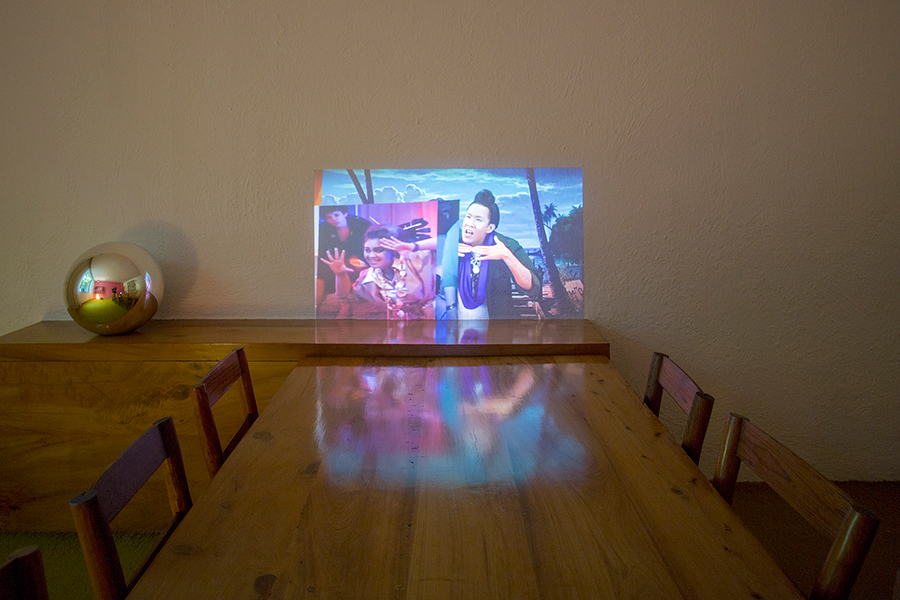Uncovering the Sexuality and Solitude of a Modern Mexican Icon
A provocative exhibition at Casa Luis Barragán reframes the architect’s home and studio through his class and gay identity
A provocative exhibition at Casa Luis Barragán reframes the architect’s home and studio through his class and gay identity

Miguel Covarrubias and Rosa Rolanda were Zeligs of Mexican modernism: the husband and wife painter-choreographer pair crop up in almost all of the movement’s primal scenes. Among these, they introduced their friend Luis Barragán to Samoan textiles, one of which the architect hung in the kitchen of his Mexico City home. Though we encounter it halfway through a tour of the house, that Pacific link provides a conceptual starting point for ‘Fraccionar’, an intriguing exhibition organized by Hong-Kong based curator Inti Guerrero, which occupies its living spaces and design studio. Though its origin is not precisely known, the bark cloth tapestry rhymes with a painting by Niuen artist John Pule, also on bark cloth, hung in the adjacent dining room and visible through an open door. Prototype-site of old Myths (1995) collages tropes of island primitivism with religious symbols and scenes of sexual ecstasy. Above stylized canoes, a man kneels before a crucifix, sporting an erection.
Barragán was an observant Catholic and closeted gay man; discreet crosses appear throughout the house, in window-cladding or above door jambs. Unlike the 'Glass House' of his closeted contemporary, Philip Johnson, Casa Barragán is a black box of privacy, more akin to a priest’s confessional than a fishbowl. ‘Thanks to a singular strategy for walls,’ the historian Juan Acha once observed, ‘every liveable space begins to revolve around itself and irradiates a convent-like solitude that invites introspection and withdrawal.’ Though Barragán was a famous host, his home has since his death acquired a monastic pink aura.

To accompany the home’s many images of Christ, Guerrero has installed José Alejandro Restrepo’s I Sell God’s Image (2004) on a shelf in its mezzanine sitting room. The photograph depicts a homeless man in Quito hawking drawings of Jesus, one of which appears in reproduction alongside it. Diamela Elitit’s disturbing video Pain Zone II/The Kiss (1982), which plays on a nearby monitor, reinforces Restrepo’s effortless wit: in it, the artist follows a homeless man through the streets of Santiago, begging him to smooch her. Though the man takes pleasure in Elitit’s abuse, the pairing of both works reminds us that God took a beggar’s image and was ultimately betrayed by a kiss. Though erroneously celebrated as a champion of Mexican vernacular architecture, Barragán was a wealthy, reclusive developer: less Restrepo’s image of Christian charity than Elitit’s exploitative performance of it.
Jesus here also means Jesus ‘Chucho’ Reyes, yet another closeted Catholic and friend of Barragán’s. Guerrero has installed two long ink paintings on paper by Reyes in the architect’s bedroom, both depicting a flagellated Christ in a style redolent of Japanese ukiyo-e. Bodily pain and transcendence are fundamental to Liliana Maresca’s No todo lo que brilla es oro (All that glitters is not gold), which the Argentine conceptualist made in 1989, when she was dying of AIDS, and which plays on a monitor in a guest bedroom. The video tracks her hands as she removes alchemical objects from a wooden box: a gold-plated square and angle, silver bars and a large mirrored orb. It’s unclear what restorative power she might draw from them, but they gesture to nearby furnishings – a gold-plated canvas by Mathias Goeritz (Job XXVIII:3, 1960) and another mirrored ball. Barragán placed one of these in each room, allowing him to monitor the doors behind him: a fitting complement to Maresca’s confrontation of her own mortality. ‘Mortals put an end to the darkness,’ reads the verse to which Goeritz’s abstract canvas refers. ‘They search the farthest recesses for ore in blackest darkness.’ Its gold leaf catches sun at certain hours, giving brief light to interior gloom.

Sexuality and solitude resurface in the show’s grandest work, Mientras me despierto (As I Wake Up, 1985) by Julio Galán. The painting depicts a young man with a sweeping cape peering out a small orange window. Pale bloodied hands claw at the edges of his emerald prison, where a sinister Dalmatian in boxer shorts wags a steak knife. Galán’s own openness as a gay man did not mean he felt any freer in his hometown of Monterrey. A tiny window beside the painting lets just a sliver of light into the room where it hangs, slyly moulded by cruciform shutters.
Fraccionar, to divide or parcel, gives root to the Fraccionamientos, or official neighbourhoods, of Mexico City. The verb applied to Barragán’s life in many ways: the modernist play of architectural volumes; the consubstantial power of the holy trinity; the irreconcilability of queerness and religious conservatism; the design of suburban housing developments. Covarrubias and Rolanda introduced Barragán to the dancer José Limón, his erstwhile lover, who poses on black volcanic rocks in a series of photographs that rest on a living room lectern. They were taken at El Pedregal, a gated development Barragán designed, and whose fusion of modern principles and hacienda architecture signalled Mexico City’s gentrification. This Barragán hardly feels like a saint; Guerrero acknowledges the contradictions inherent to his radical practice in privileged seclusion.
In an endnote to his exhibition essay, the curator piously begs our forgiveness. He reminds us that Barragán was not a popular architect: in the studio, he has installed Donna Conlon and Jonathan Harker’s Tropical Zincphony (2013), a mesmerizing video of mangoes tumbling down the weather-beaten grooves of zinc roofing. There is beauty to the shantytowns Barragán slum-cleared. Like all good critiques of hagiography, Guerrero’s show celebrates our mortals just as much as it celebrates our saints.
'Fraccionar' runs at Estancia Femsa, Casa Luis Barragán, Mexico City, until 5 May 2019.
Main image: Julio Galán, Mientras me despierto (detail), 1985. Courtesy: Estate FEMSA – Casa Luis Barragán, Mexico City; photograph: Ramiro Chaves
























